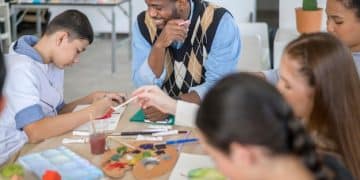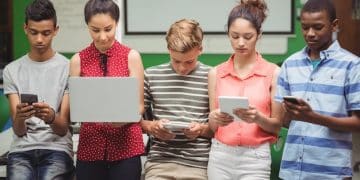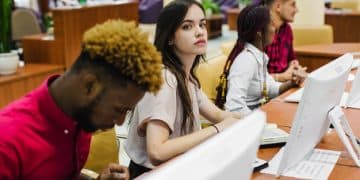Personalized Learning in US Schools: Impact on Instruction and Outcomes by 2025

The increased focus on personalized learning in US schools by 2025 is expected to transform classroom instruction through tailored approaches, technology integration, and data-driven strategies, ultimately aiming to enhance student engagement and improve academic outcomes.
How will the increased focus on personalized learning affect classroom instruction and student outcomes in US schools by 2025? This shift promises to revolutionize how students learn, but what will it really look like in practice?
The Rise of Personalized Learning in US Education
Personalized learning is rapidly gaining traction across the United States as educators seek more effective ways to cater to the diverse needs of their students. This approach moves away from the traditional one-size-fits-all model, acknowledging that each student learns at their own pace and in their own style.
The concept of personalized learning isn’t entirely new, but its implementation has been significantly enhanced by advances in technology and a growing understanding of how students learn best. It’s about creating educational experiences tailored to individual student needs, preferences, and interests.
Defining Personalized Learning
At its core, personalized learning involves customizing instruction to meet the specific needs of each student. This includes adapting the pace of learning, the content covered, and the methods used to deliver instruction. The goal is to create an environment where every student can thrive and reach their full potential.
Personalized learning also emphasizes student agency, empowering learners to take ownership of their education. It involves setting goals, making choices about what and how they learn, and reflecting on their progress.
- Individualized Instruction: Tailoring teaching methods and content to suit each student’s unique learning style and pace.
- Data-Driven Insights: Utilizing data to monitor student progress and adjust instruction accordingly.
- Student Agency: Empowering students to take control of their learning journey and make informed decisions.
- Flexible Learning Environments: Creating adaptable spaces and schedules that cater to diverse learning needs.
In conclusion, the increasing adoption of personalized learning reflects a growing recognition that students learn best when their individual needs are met. By 2025, we can expect to see even more schools embracing personalized approaches to instruction and assessment.
Impact on Classroom Instruction
The shift towards personalized learning is already having a significant impact on classroom instruction. Teachers are adopting new roles and strategies to facilitate learning in more individualized ways. Technology plays a crucial role in enabling these changes, providing tools for assessment, content delivery, and communication.
One of the biggest changes is the move away from traditional lectures and whole-class instruction. Instead, teachers are facilitating small group activities, providing one-on-one support, and using technology to deliver customized content.
Changes in Teaching Roles
In a personalized learning environment, the teacher’s role evolves from a lecturer to a facilitator, coach, and mentor. They are responsible for creating a supportive learning environment, providing individualized support, and helping students set and achieve their goals.
Teachers also need to be skilled in using data to monitor student progress and adjust instruction accordingly. This requires ongoing professional development and a willingness to embrace new technologies and teaching strategies.
Key aspects include:
- Facilitator: Guiding students through the learning process, providing resources and support as needed.
- Coach: Helping students set goals, monitor their progress, and overcome challenges.
- Data Analyst: Using data to understand student learning patterns and adjust instruction accordingly.
- Collaborator: Working with other teachers and specialists to provide comprehensive support to students.
In summary, personalized learning is reshaping classroom instruction by empowering teachers to become facilitators of learning and enabling them to provide individualized support to students.
Technology’s Role in Personalized Learning
Technology is a critical enabler of personalized learning, providing tools for assessment, content delivery, and communication. From adaptive learning platforms to virtual reality simulations, technology is expanding the possibilities for customizing instruction and engaging students in new ways.
However, it’s important to remember that technology is just a tool. The success of personalized learning depends on how effectively it is used by teachers and students. It requires careful planning, ongoing professional development, and a focus on using technology to enhance learning, not replace it.
Technology is critical for personalized learning because it allows:
- Adaptive Learning Platforms: These platforms adjust the difficulty of content based on student performance, providing a customized learning experience.
- Data Analytics: Tools that help teachers monitor student progress, identify areas of need, and inform instructional decisions.
- Digital Content: Access to a vast library of digital resources, including videos, simulations, and interactive exercises.
- Communication Tools: Platforms that facilitate communication between teachers, students, and parents.
Challenges in Implementing Technology
While technology offers many benefits, there are also challenges to consider. Access to technology, digital literacy, and data privacy are all important issues that need to be addressed to ensure that personalized learning is equitable and effective.
Furthermore, it’s crucial to avoid over-reliance on technology. Personalized learning should be about more than just using apps and devices. It needs to be grounded in sound pedagogy and a focus on building strong relationships between teachers and students.
In conclusion, technology is a powerful enabler of personalized learning, but its effectiveness depends on careful planning, ongoing professional development, and a focus on using technology to enhance learning, not replace it. It is important to consider the following barriers when implementing technology in classrooms:
- Access to Technology: Ensuring that all students have access to devices and reliable internet connectivity.
- Digital Literacy: Providing training and support to teachers and students to effectively use technology.
- Data Privacy: Protecting student data and ensuring that it is used responsibly.

Data-Driven Decision Making in Education
Data plays a crucial role in personalized learning, providing insights into student progress and informing instructional decisions. From formative assessments to learning analytics, data is helping teachers understand their students and tailor instruction to meet their needs.
However, it’s important to use data responsibly and ethically. Data should be used to support student learning, not to label or track students. Teachers need to be trained in how to interpret data and use it to make informed decisions about instruction.
Using Data to Inform Instruction
Data can be used in a variety of ways to inform instruction. For example, teachers can use formative assessments to identify areas where students are struggling and adjust their teaching accordingly. They can also use learning analytics to track student progress over time and identify patterns in their learning.
By monitoring student progress and making adjustments as needed, teachers can ensure that students are always challenged and engaged. Data-driven decision-making can help address any areas where students are struggling or excelling.
Key aspects include:
- Formative Assessments: Using quizzes, polls, and other tools to assess student understanding in real-time.
- Learning Analytics: Tracking student progress over time and identifying patterns in their learning.
- Personalized Feedback: Providing individualized feedback to students based on their performance.
Addressing Data Privacy Concerns
Data privacy is a significant concern in personalized learning. Schools need to have clear policies and procedures in place to protect student data and ensure that it is used responsibly. Parents and students need to be informed about how their data is being used and have the opportunity to opt out if they choose.
In conclusion, data plays a crucial role in personalized learning, providing insights into student progress and informing instructional decisions. The proper usage of data will only help lead to greater academic success for students.
Impact on Student Outcomes
The ultimate goal of personalized learning is to improve student outcomes. Studies have shown that personalized learning can lead to increased student engagement, improved academic performance, and greater college and career readiness. But it’s important to recognize the potential impact of a personalized learning approach to educational success.
However, it’s also important to recognize that personalized learning is not a magic bullet. It requires careful planning, ongoing professional development, and a commitment to creating a supportive learning environment. As well, it is important to understand common potential academic success drivers when implementing personalized learning programs.
Potential positive outcomes for students resulting from personalized learning:
- Increased Student Engagement: Students are more engaged when they are learning about topics that interest them and when they have a say in how they learn.
- Improved Academic Performance: Personalized learning can lead to improved test scores, grades, and graduation rates.
- Greater College and Career Readiness: Students who have experienced personalized learning are better prepared for college and careers.
Measuring Student Success
Measuring the success of personalized learning requires a shift in how we assess student learning. Traditional standardized tests may not be the best way to measure the skills and knowledge that students are acquiring in a personalized learning environment. Assessments may include self-assessment, tests, academic achievement markers, and teacher observations.
Instead, schools need to develop assessments that are aligned with the goals of personalized learning and that measure student growth over time. These assessments should be authentic and relevant to students’ lives.

Challenges and Considerations for the Future
While personalized learning holds great promise, there are also challenges and considerations that need to be addressed as we move forward. These challenges include funding, equity, professional development, and data privacy.
Addressing these challenges will require a collaborative effort from educators, policymakers, and the community. It will also require a willingness to embrace new ideas and approaches to education. It is also important to discuss the importance of equity in education throughout the implementation process.
Equity and Access
Ensuring that all students have access to personalized learning opportunities is a critical challenge. Students from low-income families and students with disabilities may face barriers to accessing technology, high-quality instruction, and other resources that are essential for personalized learning.
Schools need to address these barriers by providing additional support to these students and by ensuring that personalized learning is implemented in a way that is equitable and inclusive.
- Funding: Providing adequate funding to support personalized learning initiatives.
- Professional Development: Training teachers in how to implement personalized learning effectively.
- Data Privacy: Protecting student data and ensuring that it is used responsibly.
In conclusion, the increasing focus on personalized learning will continue to affect classroom instruction and student outcomes in US schools by 2025. Educators should be prepared to adapt their strategies for a new, more customized learning approach.
| Key Point | Brief Description |
|---|---|
| 🎯 Individualized Instruction | Tailoring teaching methods to suit unique learning styles and paces. |
| 📊 Data-Driven Insights | Using data to monitor progress and adjust instruction. |
| 💻 Technology Integration | Leveraging tech for assessment, content, and engagement. |
| 🔑 Student Agency | Empowering students to take control of learning journey. |
Frequently Asked Questions (FAQ)
▼
Personalized learning is an educational approach that tailors instruction to meet the individual needs, preferences, and interests of each learner, rather than using a standardized, one-size-fits-all method.
▼
Technology supports personalized learning through adaptive learning platforms, data analytics tools, digital content libraries, and communication tools that enable customized content delivery and progress tracking.
▼
The benefits of personalized learning include increased student engagement, improved academic performance, greater college and career readiness, and development of self-directed learning skills.
▼
Challenges include ensuring equitable access to technology, providing professional development for teachers, addressing data privacy concerns, and securing adequate funding for personalized learning initiatives.
▼
Schools can measure success by tracking student engagement, academic growth, college and career readiness, and by using assessments aligned with personalized learning goals, such as authentic and relevant assessments.
Conclusion
In conclusion, the increased focus on personalized learning is poised to significantly reshape classroom instruction and student outcomes in US schools by 2025. By leveraging technology, embracing data-driven decision-making, and prioritizing student agency, educators can create learning environments that empower every student to thrive.





